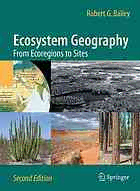
Ecosystem Geography: From Ecoregions to Sites PDF
Preview Ecosystem Geography: From Ecoregions to Sites
Ecosystem Geography From Ecoregions to Sites SecondEdition Frontispiece.ThesemiaridmountainsoftheSouthernRockyMountains,nearCrestedButte,Colorado, containnumerousexamplesofthelandforminfluencesonecosystempatterns.SlateRiver,oiloncanvas, pleinair,byShaunHorne©2004,reproducedwithpermission. Robert G. Bailey Ecosystem Geography From Ecoregions to Sites Second Edition With a Foreword by Jack Ward Thomas, Chief, USDA Forest Service Illustrations by Lev Ropes and Nancy Maysmith With 142 Illustrations in 154 Parts 123 RobertG.Bailey RockyMountainResearchStation USDAForestService 240WProspectRoad FortCollins,CO80526 USA [email protected] Additionalmaterialtothisbookcanbedownloadedfromhttp://extra.springer.com ISBN978-0-387-89515-4 (hardcover) e-ISBN978-0-387-89516-1 ISBN978-1-4419-0391-4 (softcover) DOI10.1007/978-0-387-89516-1 SpringerNewYorkDordrechtHeidelbergLondon LibraryofCongressControlNumber:2009928500 ©SpringerScience+BusinessMedia,LLC1996,2009 NocopyrightisclaimedinworkspreparedbyanofficeroremployeeoftheUnitedStatesGovernmentaspart ofthatperson’sofficialduties. All rights reserved. This work may not be translated or copied in whole or in part without the written permissionofthepublisher(SpringerScience+BusinessMedia,LLC,233SpringStreet,NewYork,NY10013, USA),exceptforbriefexcerptsinconnectionwithreviewsorscholarlyanalysis.Useinconnectionwithany formofinformationstorageandretrieval,electronicadaptation,computersoftware,orbysimilarordissimilar methodologynowknownorhereafterdevelopedisforbidden. The use in this publication of trade names, trademarks, service marks, and similar terms, even if they are notidentifiedassuch,isnottobetakenasanexpressionofopinionastowhetherornottheyaresubjectto proprietaryrights. Coverillustration(clockwisefromtopleft):Ecoregiondivisionsmap(level2oftheecoregionhierarchy)ofthe world(Source:MicrosoftVirtualGlobe©1995–1998,MicrosoftCorporation;mapreprintedwithpermission from Microsoft Corporation) – Landscape mosaic consisting of spruce forests and glacially scoured lakes, warmcontinentaldivision,Minnesota(PhotographbyJackBoucher,NationalParkService)–Montaneforest site, subtropical steppe mountains, Arizona (Photograph by Robert G. Bailey) – Semidesert site, subtropical steppedivision,Arizona(PhotographbyRobertG.Bailey)–Desertsite,subtropicaldesertdivision,Arizona (PhotographbyRobertG.Bailey) Printedonacid-freepaper SpringerispartofSpringerScience+BusinessMedia(www.springer.com) Foreword Land management is presently undergoing enormous change: away from managing single resources to managing ecosystems. From for- est to tundra, to desert, to steppe, the world’s ecosystems vary vastly. Tomanagethemeffectivelyweneedtounderstandtheirgeographicdis- tribution better. We need to do this at various levels of detail because ecosystemsexistatmultiplescalesinahierarchy,fromregionaltolocal. Maps are needed to display ecosystem distribution and hierarchy. Until now, information on defining ecosystem boundaries has been scarce. This book is the first to clarify and systematize the underlying principlesfortheirmapping.Itpresentsasynthesisoftheknowledgein thisfieldandprovidesaguidetoitsuse. I recommend this book to all who are involved in the study and man- agementofecosystems. Chief,USDAForestService JackWardThomas v Preface to the Second Edition This book outlines a system that organizes the Earth into a hierarchy of increasingly finer-scale ecosystems that can serve as a consistent frameworkforecologicalanalysisandmanagement.Thesystemconsists ofathree-levelhierarchyofnestedecosystemunitsandtheirassociated mapping criteria. Delineation of units involves identifying the environ- mental factors controlling the spatial geography of ecosystems at vari- ous levels and establishing boundaries where these factors change sig- nificantly. Macroscale units (ecoregions) are climatically controlled and delineatedasKöppen–Trewarthaclimatezones.Nestedwithintheseare landscape mosaics, the mesoscale units, controlled by landform and delineated by Hammond’s landform regions. At the microscale are indi- vidual sites controlled by topographically determined topoclimate and soilmoistureregimes. The first edition of this work (1996) was written at a time when few publishedmaterialsonecosystemgeographywereavailable,andnoneof these had systematically elaborated the principles underlying the map- ping of ecosystems in a form accessible to advanced students and prac- titioners. This second edition builds on the strengths of its predecessor, incorporates new information, clarifies concepts presented in the first edition,andcontainsnewsections. Thenewsectionsaddresshowecoregionboundariesweredetermined, ecoregion redistribution under climate change, ecosystem processes (such as fire regimes), empirical versus genetic approaches to classifi- cation,andhumanmodificationtoecosystems(forinstance,throughthe introductionofinvasivespecies). Once again, I would like to thank many people who have made the completion of this book possible: Nancy Maysmith for re-creating many vii viii PrefacetotheSecondEdition ofthefirsteditiondiagramsanddrawingseveralnewones,andtoShaun Horne for the frontispiece; Michael Wilson and Renee O’Brien, Pro- gram Manager and Deputy Program Manager, respectively, for Inven- tory, Monitoring, and Analysis at the Rocky Mountain Research Sta- tion, for their support; and Eric Smith of the U.S. Forest Service for his review and suggested improvements in the section on climate change. I appreciate the helpful criticism of several reviewers of the first edi- tion, but I should mention especially Richard Huggett, Hartmut Leser, Randy Rosiere, Robert Smith, Duane Griffin, Kenneth Young, John Fed- kiw, Steven Jennings, David Scarnecchia, Fred Smeins, and Melinda Knutson. As always, it has been a pleasure to work with Janet Slobod- ienatSpringerintranslatingthisworktoprint. FortCollins,Colorado RobertG.Bailey December2008 Preface to the First Edition The management of public land needs a new approach. To fill this need, many public land-management agencies in the United States and abroad are working toward the management of ecosystems rather thanthemanagementofindividualresources.Historically,theecosystem hasbeendefinedasasmallhomogeneousarea,suchasastandoftreesor ameadow.Todaythereareseveralreasonsforrecognizingecosystemsat broader scales. Because of the linkages between systems, a modification ofone systemmayaffecttheoperation ofsurrounding systems.Further- more,howasystemwillrespondtomanagementispartiallydetermined by relationships with surrounding systems. Understanding these rela- tionshipsisimportantinanalyzingcumulativeeffects,withactionatone scale and effects at another. This has created the need to subdivide the landintoecosystemsofdifferentsize(orscale)basedonhowgeographi- callyrelatedsystemsarelinked.Thisbookexploresanewapproach:one involving ecosystem geography, the study of the distribution and struc- ture of ecosystems as interacting spatial units at various scales, and the processesthathavedifferentiatedthem. The basic concepts about scale and ecosystems are discussed in text- books on landscape ecology and geography (cf. Isachenko 1973; Leser 1976; Forman and Godron 1986). I have presented a synthesis of these concepts elsewhere (Bailey 1985). In follow-up publications (Bailey 1987,1988a),Isuggestedcriteriaforsubdividinglandareasintoecosys- temsandprovidedadiscussionofapplications.Ialsoshowedhowexist- inginformationandmapscouldbeusedtomapecosystems.Thescheme that serves as the framework of this book was first devised as a train- ing program for my course in multiscale ecosystem analysis for the U.S. ix x PrefacetotheFirstEdition Forest Service. This publication updates and expands the knowledge of thesubject. My thanks to David H. Miller and J. Stan Rowe; their work was the intellectualbackgroundforthisbook.Iwouldalsoliketoextendthanks for the inspiration provided by John M. Crowley, who introduced me to thefascinationofecosystemgeography. Lev and Linda Ropes helped me to elaborate and illustrate the ideas that help hold this book together. The maps were made by Jon Havens, whose skill and patience have been invaluable. I am also indebted for someofthedrawingstoSusanStrawn,whoalsowasanalertcritic. FortCollins,Colorado RobertG.Bailey March1995
